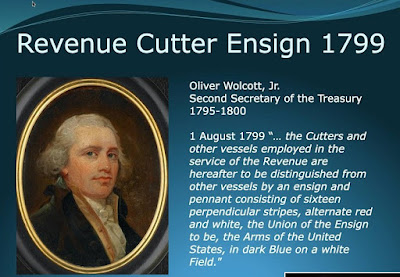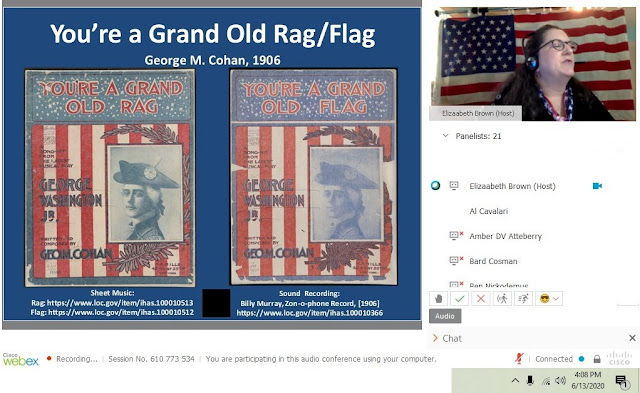Jim Ferrigan replayed his award winning presentation about A Flag Incident in San Francisco in 1984. Back in 1984 the Confederate flag flew along side several other flags at the San Francisco State House. Attempts to get it removed peacefully were ignored, so a left leaning socialist group conducted a civil disobedient raid to remove the Confederate flag—which was a kin to the first version of the Confederate Naval Jack.
Many in the public do not realize that the popular Confederate flag is not the official flag of the Confederacy. The popular Confederate flag is the de facto flag of the Confederacy and is usually associated with official battle flag of the Confederacy. But this flag mostly closely resembles the second Naval Jack of the Confederacy.
In 1984 Ritchie Bradly dressed in Northern Civil War attire and proceeded to take down the Confederate flag at the San Francisco State House. You can see him standing in front of a reproduction of the 'Union Fort Sumter' flag of South Carolina, where the official start of the US Civil War began.
Richard Bradly was a part of a left-wing socialist organization. His demonstration of active civil disobedience took place with supporters who wished to see the Confederate flag removed from the San Francisco public property and promote a worker's socialist agenda. One banner reads: 'DOWN WITH THE CONFEDERATE FLAG OF SLAVERY & THE KKK! LABOR BLACK LEAGUE FOR SOCIAL JUSTICE! Another banner reads: 'FINISH THE CIVIL WAR! ONWARD TO A WORKERS STATE!'
You can see the flag being torn down by Dick Bradly. He was later released and the drama continued with a new flag, and several others until it was finally replaced. The Confederate flag was one of many that represented the heritage of California.
Although the Confederacy never saw any military action or gained traction in California, other nation states were able to make an impact on California that would have made a better replacement like the Russian-American Company due to the colony at Ft. Ross; or the Argentina flag when Hippolyte Bochard occupied Monterey in 1818. There was also the early US occupation of California in 1842 when Catesby Jones seized Monterey, when the US only had 26 states.
Translate
Saturday, June 13, 2020
#7. Neḥushtan at Sea: What is Fouling that Anchor?—Bard Cosman
Bard Cosman gave a fascinating paper on the icon of the fouled anchor. He ascribed it to Biblical origins. A popular design for flags and in heraldry is a snake on an anchor. Cosman described its connections and symbolism, that can swing between being a rope and being a snake.
Cosman showed us several examples of the snake on the cross or staff, which was known as the Brazen serpent or nehushtan. Although snakes and serpents are associated with evil it is quite ironic that this symbol has also become a symbol of good, almost like a Yin and Yang.
Below Cosman showed us an illustration of the Anchor and it use as printer's marks as the 'Sacred Anchor' of Christ.
Cosman showed us several examples of the snake on the cross or staff, which was known as the Brazen serpent or nehushtan. Although snakes and serpents are associated with evil it is quite ironic that this symbol has also become a symbol of good, almost like a Yin and Yang.
Below Cosman showed us an illustration of the Anchor and it use as printer's marks as the 'Sacred Anchor' of Christ.
NAVA 54: Presenting NAVA 55:Next Year's Meeting at St. Augustine, again, by Amber Atteberry
Like all NAVA meetings, a presentation for the next NAVA meeting was given. Amber Atteberry gave an overview of the facility at appropriately named Flagler College. There is a planned visit to the oldest masonry fort in the United States: the Castle of St. Mark (Castillo de San Marcos).
Flagler college is supreme college of elegance.
#6. United States Revenue-Marine and Customs Flags: A New Perspective—David B. Martucci
 |
| Can you spot the correct 16 striped Cutter flag? |
This flag received it official prescription on August 1, 1799. It described this flag with 16 perpendicular stripes of alternate red and white with the Arms of the United States in the canton to be dark blue and on a white field.
Martucci pointed out, since the official description of the flag in 1799 had 16 stripes because there were 16 states in the Union. Likewise many flags of the USA had 16 stripes as well.
By the time 1818 rolled around the US had 21 states. Thus many US flags has 21 stars with 21 stripes. With too many stripes, the US flag was given its final modern design algorythm by Captain Samuel Reid; it states that the stripes would remain as 13 for history and the canton would add stars as states were included.
The Revenue Cutter Marine also appeared on the Seal of several government organizations. From 1874 until 1900 it was on the right side of the US Treasury Department Seal as used on Customs Documents from 1874 to 1900. Likewise the US Customs Service Seal used it sometime in the 1880s and 1890s.
Note that before income taxes, a lot of cash for the government was raised with this 'Guardian Paramilitary Entry Port Custom's Duty Force' better known as the Revenue Cutter Service.
 |
| Dave Martucci at NAVA 54 Online with Library of Congress - Can you spot the correct 16 striped Cutter flag?
Later in the day the Revenue Cutter Service flag for the Confederacy was shown during last presentation by Jim Farrigan. The Confederate Revenue cutter flag had seven stars in the canton and looked remarkably like to flag of France, minus the stars.
Further details of Martucci's presentation is scheduled to a appear in an up coming issue of Vexillum. Martucci was the president of NAVA from 1998-2004. Link to Martucci's Website: http://www.vexman.net |
#5. The Unwaved Flag in Churches—Benjamin Nickodemus
Benjamin Nickodemus gave a paper on an observation a European immigrant to the United States who experienced culture shock in many of the US Churches he visited. The shocking element was the placement of the US flag near the holy of holy altars. Not all churches in the US have flags in the church, but many set it on one of the flanking sides. Although the US may pride herself on separation of the state and church, many churches are actively pro-inclusive to include symbols of the state in their church.
Nickodemus pointed out that many churches also fly the church flag along side the US flag, which is a white field with a blue canton and red cross. However, Catholic Churches do not fly the 'protestant' Christian flag, instead they sometimes fly the Vatican flag, which is usually nowhere near the holy of holy altars.
Although the US promotes the separation of Church and State it may seem peculiar to some, that highest symbol of the state would be in a Church. On the other hand, the use of Christian imagery within the state is ever so present. Many legislative leaders are sworn in upon the Bible, likewise Christmas is a recognized Federal holiday. Also note, US federal government does not recognize any Jewish, Muslim, Buddhist, Hindu, Shinto or Native American Religious Holiday—only Christian Holidays.
#4. The American Thin Blue Line Flag: A Controversial Success Story—Scott Mainwaring
The fourth NAVA 54 presentation was given by Scott Mainwaring. Mainwaring gave the award winning William Driver presentation of NAVA 54 on the topic of the American Thin Blue Line flag. The known history and over all impact of this flag was providentially timed, due to the current cultural crisis facing America and the Western World, with the issues of police brutality and racial injustice.
Much of the popularity of the Thin Blue Line US Flag can be traced to the efforts of Andrew Jacob. Jacob created the flag in 2014 and had the marketing know how, to push it to market as a freshman at the University of Michigan. The original design may have come from a flag patch that was inspired by the US or UK flag patch.
Another point of inspiration for the Thin Blue Line American flag is its derivation from the original black and blue police flag. The horizontal tribar of black, blue, and black honors officers that have fallen in the line of duty. Likewise the black and blue flag is the older thin blue line flag that represents all persons in law enforcement, irrespective of nationality.
Mainwaring also showed us that the thin blue line flag was replicated across national borders. To the left, versions of The Thin Blue Line flag for the UK, Canada, are Philippines visible.
Tje video below was also presented online. Scott pointed out this is one of the few unofficial flags to have quasi-official backing from the police department.
Dr. Mainwaring's Website
http://scottmainwaring.com
Much of the popularity of the Thin Blue Line US Flag can be traced to the efforts of Andrew Jacob. Jacob created the flag in 2014 and had the marketing know how, to push it to market as a freshman at the University of Michigan. The original design may have come from a flag patch that was inspired by the US or UK flag patch.
Another point of inspiration for the Thin Blue Line American flag is its derivation from the original black and blue police flag. The horizontal tribar of black, blue, and black honors officers that have fallen in the line of duty. Likewise the black and blue flag is the older thin blue line flag that represents all persons in law enforcement, irrespective of nationality.
Mainwaring also showed us that the thin blue line flag was replicated across national borders. To the left, versions of The Thin Blue Line flag for the UK, Canada, are Philippines visible.
Tje video below was also presented online. Scott pointed out this is one of the few unofficial flags to have quasi-official backing from the police department.
Dr. Mainwaring's Website
http://scottmainwaring.com
US Library of Congress Librarian - Elizabeth Brown
Brown demonstrated how to search the Library of Congress website. The example she provided was about You're a Grand Old Flag 1906 by George M. Cohan. It originally was called You're a Grand Old Rag. However due to peer pressure for reverence of the US flag, Rag was replaced with Flag.
Subscribe to:
Comments (Atom)

















